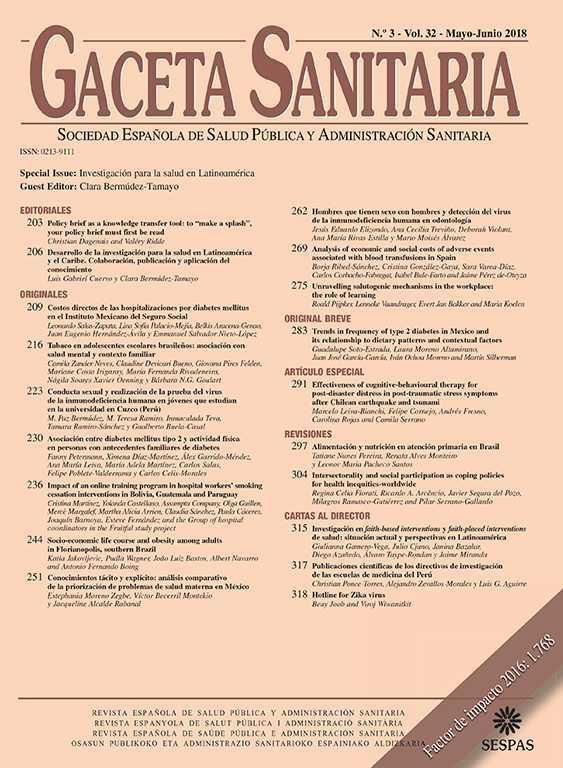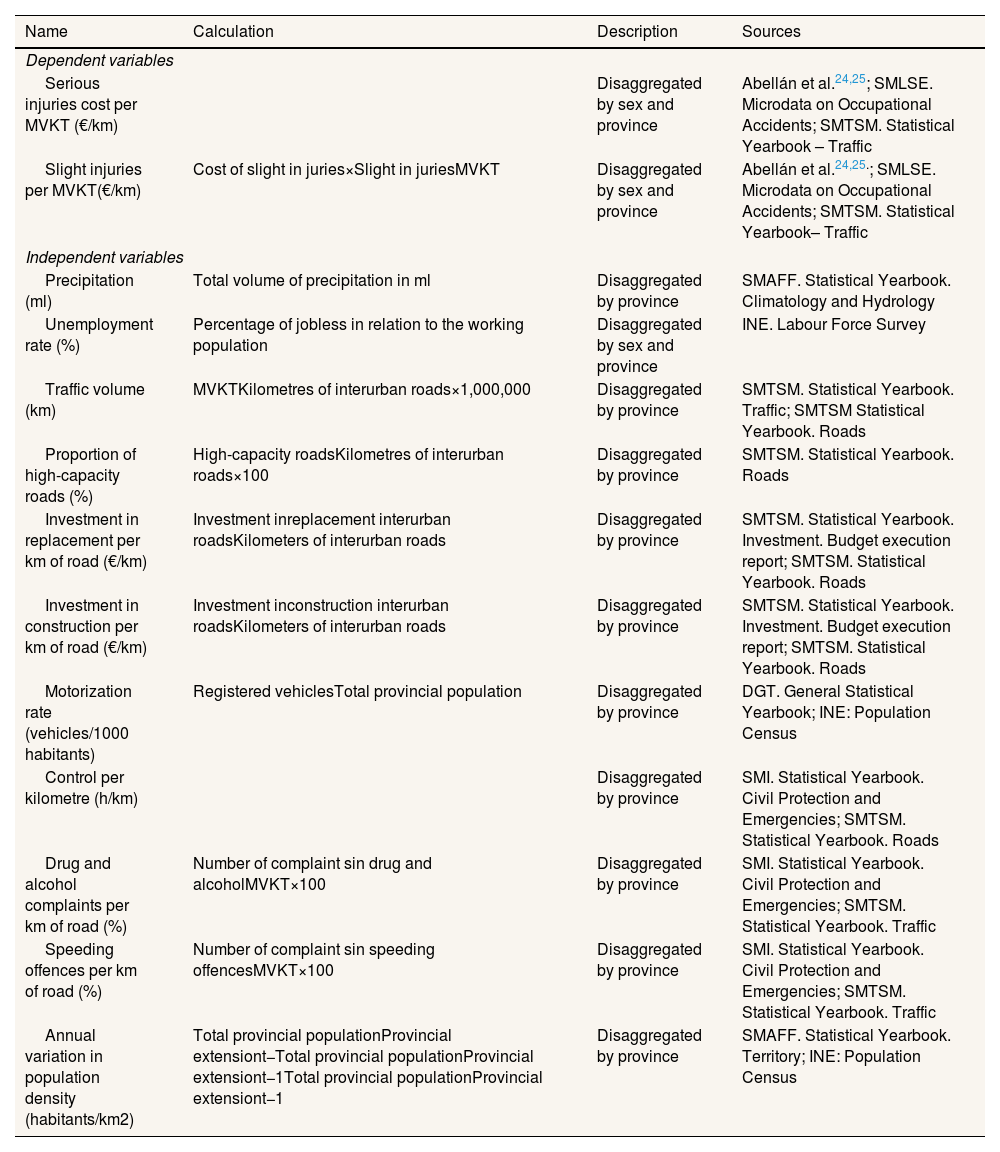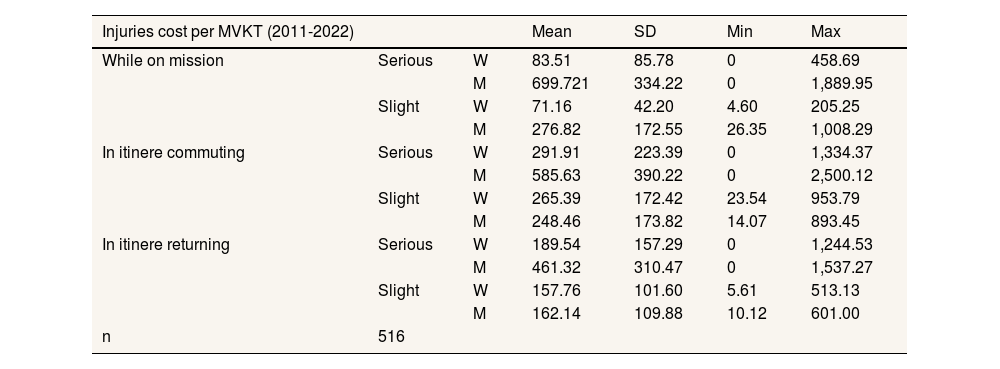To identify and evaluate the economic, technical, social, and legislative factors influencing the social costs of work-related road traffic injuries across Spanish provinces during 2011–2022. The analysis differentiates by injury severity (serious or slight) and by type of injury (“while on mission” or “in itinere”). Special attention is given to the worker's sex as a differentiating factor.
MethodPanel data regression models were applied to analyse the relationship between the social cost of work-related traffic injuries and several contextual variables identified in previous studies, such as infrastructure investment, motorization rates, and the implementation of road safety controls, among others.
ResultsMarked heterogeneity was observed across provinces. Higher unemployment rates were associated with lower overall injury costs, but with increased costs of serious commuting injuries for women on their way to work (coef.: 2.84) and for men on their way home (coef.: 2.69). The enforcement of traffic laws was associated with a reduction in costs; however, risks related to substance use may offset this effect in serious injuries among men on duty (coef.: 3.65) and women returning home (coef. 2.09).
ConclusionsThe combined influence of economic, social, and legislative factors on the social costs of work-related traffic injuries is confirmed. The findings underscore the need for integrated mobility policies and occupational risk prevention strategies that enhance safety, reduce exposure, and address sex and regional differences.
Identificar y evaluar los factores económicos, técnicos, sociales y legislativos que influyen en los costes sociales de los accidentes de tráfico laborales en las provincias españolas durante el periodo 2011-2022. El análisis distingue según la gravedad de las lesiones (graves o leves) y el tipo de accidente («en misión» o «in itinere»), con especial atención al sexo de la persona trabajadora como factor diferenciador.
MétodoSe aplicaron modelos de regresión con datos de panel para analizar la relación entre el coste social de los accidentes laborales de tráfico y diversas variables contextuales identificadas en estudios previos, como la inversión en infraestructuras, la tasa de motorización y la implementación de controles de seguridad vial.
ResultadosSe observó una marcada heterogeneidad entre provincias. El desempleo se asoció con una reducción global de los costes, aunque con un aumento de los costes en accidentes graves in itinere en mujeres de camino al trabajo (coef.: 2,84) y en hombres al regresar a su domicilio (coef.: 2,69). El cumplimiento de la normativa de tráfico se asoció con una reducción de los costes; sin embargo, los riesgos asociados al consumo de sustancias pueden contrarrestar este efecto en los accidentes graves de hombres en misión (coef.: 3,65) y mujeres al regresar a casa (coef.: 2,09).
ConclusionesSe confirma la influencia combinada de factores económicos, sociales y legislativos en los costes sociales de los accidentes laborales de tráfico. Los hallazgos subrayan la necesidad de políticas de movilidad y prevención de riesgos laborales integradas, que mejoren la seguridad, reduzcan la exposición y consideren las diferencias por sexo y territorio.
Traffic injuries and work-related health problems are among the leading causes of death worldwide.1,2 However, previous literature has pointed out that, although traffic injuries occurring during work activities represent a significant proportion of occupational fatalities in industrialized countries, research on the underlying risk factors remains limited.3 These incidents harm companies through productivity loss, legal issues, and reputational damage, while also burdening public health systems, lowering household income, and reducing overall economic participation.4 This study aims to analyse these broader social impacts, understood as externalities that, although originating in the business sphere, also affect communities and national economies.
Understanding the root causes of work-related road traffic injuries is essential for designing effective prevention strategies.5 Corporate measures can thus complement public policy efforts to reduce risk.6 These injuries intersect two domains, traffic and occupational risks, and should be classified as either “while on mission” (during work duties) or “in itinere” (commuting to or from work).
A substantial body of literature has explored various factors to explain both occupational and traffic-related injuries, although traditionally approached individually. Among other factors, the literature highlights that weather conditions are a significant factor in work-related road injuries.5,7,8 Similarly, macroeconomic indicators also influence these injuries.7,9,10 Unemployment11,12 and gross domestic product (GDP)13 are commonly used to represent economic activity and employment status.
Socioeconomic factors such as population density and education levels are also relevant.7,14 Another socioeconomic factor often linked to both types of injuries is alcohol consumption and policies aimed at limiting it.15
Legislative measures, such as the penalty point system, have been studied as playing a key role in reducing traffic-related injuries.5,16 Similarly, the literature emphasizes that enforcement and monitoring strategies are crucial for influencing traffic behavior.17
Road conditions and infrastructure investment significantly affect injury risk for all road users, including cyclists and pedestrians.18 Likewise, exposure, measured in vehicle kilometres travelled, and motorization rate are key variables.5,19
Finally, gender differences are observed in the literature, particularly in studies on work-related injuries. The relationship is not entirely clear. For example, injury rates during working hours are significantly higher among men, whereas commuting-related injury rates are higher among women.20
The study contributes to the literature by addressing both injury severities together, an approach rarely taken, thus improving the understanding of shared risk factors. It builds a robust provincial-level database, primarily using official records provided by the Spanish Ministry of Labour and Social Economy, along with other publicly available official sources. The study introduces a methodological innovation by adapting the data to estimate the social costs of work-related traffic injuries.
Sex-based disaggregation allows for the inclusion of a sex perspective, highlighting potential structural inequalities in occupational traffic risks. Spanish provinces are a suitable unit of analysis due to the availability of longitudinal data and their diverse labour policies, sectoral structures, and mobility patterns.5,7
This study analyses factors influencing the social costs of serious and slight work-related road injuries in Spanish provinces (2011–2022), disaggregated by workers’ sex, using panel data regression.
MethodStudy design: geographical and temporal scope of the studyTo address the proposed objective, an ecological study based on aggregated data from 43 Spanish provinces spanning the period 2011–2022 was conducted. The timeframe was selected based on data availability, comparability, and relevance for the analysis. From 2011 onwards, official sources began to provide harmonized and complete datasets for most Spanish provinces, enabling consistent monitoring over time. The endpoint in 2022 ensures the inclusion of finalized and recent data, reflecting the most up-to-date situation prior to publication. This timeframe allows for the identification of trends, cyclical variations, and the effects of public policies on work-related road injuries.
Ceuta and Melilla were excluded due to their small population size and low case numbers, which could distort statistical analyses. The Basque Country and Catalonia were also omitted due to the lack of key records linked to their autonomous competences in traffic and labour matters, hindering homogeneous comparisons with the rest of the territories.
Methodological approach: statistical analysisThe methodological approach applied is based on a panel data regression model, generically specified as follows:
where yit is dependent variable for province i in year t, XKit is explanatory variables of the model, and μit is composite error term.
This method allows for the combination of cross-sectional and time-series information, enabling control over unobservable heterogeneity between territories and improving the robustness of the estimates, which is essential for meeting the stated objective.
The choice between fixed and random effects in each model was based on overidentification tests (Table 1). Tests for homoscedasticity (Wald test), autocorrelation (Wooldridge test) and contemporaneous correlation (Pesaran's test) were conducted to identify the most appropriate model specification that could address initial econometric issues. These issues were tackled using panel-corrected standard errors, which provide consistent and robust estimates.5,21
Statistical tests of the initially estimated model coefficients (p-values shown in parentheses).
| Test | While on mission | In itinere commuting | In itinere returning | |||||||||
|---|---|---|---|---|---|---|---|---|---|---|---|---|
| Serious | Slight | Serious | Slight | Serious | Slight | |||||||
| W | M | W | M | W | M | W | M | W | M | W | M | |
| Modified Wald test (FE)(heteroskedasticity) | 533.08(<0.0001) | 638.44 (<0.0001) | 916.40 (<0.0001) | 949.98(<0.0001) | 416.52(<0.0001) | 5349.72(<0.0001) | 1826.95(<0.0001) | 828.87(<0.0001) | 1201.11(<0.0001) | 788.66(<0.0001) | 938.49(<0.0001) | 899.60 (<0.0001) |
| Pesaran's test (FE)(contemporaneous correlation) | 2.882(0.0040) | 3.315(0.0009) | 8.105(<0.0001) | 11.504(<0.0001) | -0.080(0.9364) | 5.424(<0.0001) | 5.748,(<0.0001) | 2.716(0.0066) | 3.961(0.0001) | 2.341(0.0192) | 3.865(0.0001) | 2.836(0.0046) |
| Levene's test (RE)(homoscedasticity) | 2.990(<0.0001) | 1.6470.0081 | 2.9194(<0.0001) | 4.173(<0.0001) | 2.0268 (<0.0001) | 2.9772(<0.0001) | 5.6767(<0.0001) | 3.7050(<0.0001) | 1.8220(0.0018) | 2.0155(0.0003) | 4.7458(<0.0001) | 3.1195(<0.0001) |
| Pesaran's test (RE)(contemporaneous correlation) | 0.872(0.3832) | 5.683(<0.0001) | 8.846(<0.0001) | 10.617(<0.0001) | 0.663(0.5076) | 5.513(<0.0001) | 6.285(<0.0001) | 2.795(0.0052) | 3.961(0.0001) | 2.479(0.0132) | 4.381(<0.0001) | 3.103(0.0019) |
| Wooldridge test(autocorrelation in panel data) | 4.383(0.0425) | 0.116(0.7352) | 15.109 (0.0004) | 20.896(<0.0001) | 0.043(0.8362) | 0.574(0.4531) | 12.663(0.0010) | 19.145(0.0001) | 1.913(0.1742) | 0.554(0.4611) | 12.080 (0.0012) | 9.806(0.0032) |
| Hausman test(to determine whether FE or RE are more appropriate) | 17.41 (0.0658) | 42.75(<0.0001) | 20.10(0.0283) | 63.78(<0.0001) | 12.81(0.2343) | 4.74(0.9081) | 45.45(<0.0001) | 58.63(<0.0001) | 10.47 (0.4004) | 7.55(0.6730) | 43.67(<0.0001) | 51.80(<0.0001) |
| Sargan-Hansen(to determine whether FE or RE are more appropriate) | 42.094(0.000) | 37.072(0.0001) | 61.804(<0.0001) | 91.036(<0.0001) | 14.937(0.1854) | 6.725(0.8208) | 39.924(<0.0001) | 48.122(<0.0001) | 10.603(0.4771) | 8.454(0.6722) | 31.940(0.0008) | 47.346 (<0.0001) |
FE: fixed effects; M: men; RE: random effects; W: women.
Diagnostic tests were performed for the variables, including checks for unit roots, endogeneity, and multicollinearity. Regarding the diagnostic checks, it is worth noting that lagged variables were employed to address endogeneity problems. Multicollinearity observed in the population density variable was resolved through first-differencing. Once addressed, the mean variance inflation factor remained below the threshold of 10, indicating acceptable levels of multicollinearity.
DatabaseTables 2-4 present the main characteristics and sources of all variables selected for the study, which were used to construct the database.
Description and data source of the dependent and independent variables used in the empirical analysis (2011-2022).
| Name | Calculation | Description | Sources |
|---|---|---|---|
| Dependent variables | |||
| Serious injuries cost per MVKT (€/km) | Disaggregated by sex and province | Abellán et al.24,25; SMLSE. Microdata on Occupational Accidents; SMTSM. Statistical Yearbook – Traffic | |
| Slight injuries per MVKT(€/km) | Cost of slight in juries×Slight in juriesMVKT | Disaggregated by sex and province | Abellán et al.24,25.; SMLSE. Microdata on Occupational Accidents; SMTSM. Statistical Yearbook– Traffic |
| Independent variables | |||
| Precipitation (ml) | Total volume of precipitation in ml | Disaggregated by province | SMAFF. Statistical Yearbook. Climatology and Hydrology |
| Unemployment rate (%) | Percentage of jobless in relation to the working population | Disaggregated by sex and province | INE. Labour Force Survey |
| Traffic volume (km) | MVKTKilometres of interurban roads×1,000,000 | Disaggregated by province | SMTSM. Statistical Yearbook. Traffic; SMTSM Statistical Yearbook. Roads |
| Proportion of high-capacity roads (%) | High-capacity roadsKilometres of interurban roads×100 | Disaggregated by province | SMTSM. Statistical Yearbook. Roads |
| Investment in replacement per km of road (€/km) | Investment inreplacement interurban roadsKilometers of interurban roads | Disaggregated by province | SMTSM. Statistical Yearbook. Investment. Budget execution report; SMTSM. Statistical Yearbook. Roads |
| Investment in construction per km of road (€/km) | Investment inconstruction interurban roadsKilometers of interurban roads | Disaggregated by province | SMTSM. Statistical Yearbook. Investment. Budget execution report; SMTSM. Statistical Yearbook. Roads |
| Motorization rate (vehicles/1000 habitants) | Registered vehiclesTotal provincial population | Disaggregated by province | DGT. General Statistical Yearbook; INE: Population Census |
| Control per kilometre (h/km) | Disaggregated by province | SMI. Statistical Yearbook. Civil Protection and Emergencies; SMTSM. Statistical Yearbook. Roads | |
| Drug and alcohol complaints per km of road (%) | Number of complaint sin drug and alcoholMVKT×100 | Disaggregated by province | SMI. Statistical Yearbook. Civil Protection and Emergencies; SMTSM. Statistical Yearbook. Traffic |
| Speeding offences per km of road (%) | Number of complaint sin speeding offencesMVKT×100 | Disaggregated by province | SMI. Statistical Yearbook. Civil Protection and Emergencies; SMTSM. Statistical Yearbook. Traffic |
| Annual variation in population density (habitants/km2) | Total provincial populationProvincial extensiont−Total provincial populationProvincial extensiont−1Total provincial populationProvincial extensiont−1 | Disaggregated by province | SMAFF. Statistical Yearbook. Territory; INE: Population Census |
DGT: Spanish Directorate-General for Traffic; INE: Spanish National Statistics Institute; MVKT: million vehicle kilometres travelled; SMAFF: Spanish Ministry of Agriculture, Fisheries and Food; SMI: Spanish Ministry of the Interior; SMLSE: Spanish Ministry of Labour and Social Economy; SMTSM: Spanish Ministry of Transport and Sustainable Mobility.
Descriptive statistics (mean, standard deviation, minimum, maximum) of the dependent variables.
| Injuries cost per MVKT (2011-2022) | Mean | SD | Min | Max | ||
|---|---|---|---|---|---|---|
| While on mission | Serious | W | 83.51 | 85.78 | 0 | 458.69 |
| M | 699.721 | 334.22 | 0 | 1,889.95 | ||
| Slight | W | 71.16 | 42.20 | 4.60 | 205.25 | |
| M | 276.82 | 172.55 | 26.35 | 1,008.29 | ||
| In itinere commuting | Serious | W | 291.91 | 223.39 | 0 | 1,334.37 |
| M | 585.63 | 390.22 | 0 | 2,500.12 | ||
| Slight | W | 265.39 | 172.42 | 23.54 | 953.79 | |
| M | 248.46 | 173.82 | 14.07 | 893.45 | ||
| In itinere returning | Serious | W | 189.54 | 157.29 | 0 | 1,244.53 |
| M | 461.32 | 310.47 | 0 | 1,537.27 | ||
| Slight | W | 157.76 | 101.60 | 5.61 | 513.13 | |
| M | 162.14 | 109.88 | 10.12 | 601.00 | ||
| n | 516 |
M: men; MVKT: million vehicle kilometres travelled; SD: standard deviation; W: women.
Descriptive statistics (mean, standard deviation, minimum, maximum) of the independent variables.
| Independent variables (2011-2022) | Mean | SD | Min | Max | ||||
|---|---|---|---|---|---|---|---|---|
| W | M | W | M | W | M | W | M | |
| Precipitation | 518.15 | 312.44 | 59 | 2176 | ||||
| Unemployment rate | 21.80 | 17.73 | 7.87 | 7.20 | 8.46 | 5.54 | 44.83 | 40.28 |
| Traffic volume | 1,403,351 | 1,200,671 | 285,952.9 | 7,403,920 | ||||
| Investment in replacement per km of road | 11.22 | 6.42 | 0 | 47.59 | ||||
| Investment in construction per km of road | 11.27 | 14.17 | 0 | 136.62 | ||||
| Motorization rate | 153.06 | 37.00 | 45.27 | 688.82 | ||||
| Proportion of high-capacity roads | 10.36 | 5.25 | 3.13 | 29.75 | ||||
| Drug and alcohol complaints per km of road | 7.59 | 3.33 | 2.01 | 25.82 | ||||
| Speeding offences per km of road | 0.15 | 0.27 | 0 | 4.48 | ||||
| Control per km | 60.29 | 35.11 | 18.53 | 257.99 | ||||
| Annual variation in population density | 0.08 | 0.73 | –6.33 | 7.48 | ||||
| n | 516 | |||||||
M: men; SD: standard deviation; W: women.
The dependent variable in this study is the social cost, expressed per number of serious or slight injuries and adjusted by million vehicle kilometres travelled (MVKT).22–24 Using rates allows for inter-territorial comparisons, enhancing the precision of the conclusions5,22 (Fig. 1). To capture the diversity of injury contexts, the analysis distinguishes between type of journey (on duty, commuting to work, and commuting back from work), injury severity (serious or slight), and sex (male or female). This three-way classification leads to twelve separate models, each corresponding to a distinct dependent variable.
These costs are based on estimates by Abellán et al.25,26. These studies were selected for two main reasons. First, they were officially used by Spanish Directorate-General for Traffic (DGT). Second, these calculations are based on a widely recognized methodology: the willingness-to-pay approach, which reflects how much society is willing to invest to prevent or mitigate the negative impacts of traffic-related incidents. This approach is particularly relevant in the context of this study, as work-related traffic injuries are treated as externalities. Therefore, the willingness-to-pay concept aligns well with the logic of the analysis. The estimates were calculated considering the statistical value of life, net production losses (gross in the case of injured individuals), and associated medical costs.24
The initial cost estimates were € 219,000 for a serious non-fatal injury and € 6100 for a slight non-fatal injury. The original 2011 estimates were updated for the 2011–2022 period using GDP growth rates, following recommendations from the original authors and previous literature that has applied these values.24
The number of work-related road injuries was obtained from microdata on “occupational accidents” provided by the Spanish Ministry of Labour. The analysis was conducted solely for academic and research purposes, in accordance with the principles of confidentiality, integrity, and transparency. Furthermore, the study received approval from the Research Ethics Committee of the Castilla-La Mancha University (reference: CEIS-2024-52505).
Differentiating injury severity was essential for building the database, with an econometric model estimated for each type of victim, disaggregated by sex, given the importance attributed to this variable in the literature. Additionally, “while on mission” and “in itinere” injuries were treated separately, yielding distinct results. For the latter, it was particularly important to distinguish between journeys to and from work (Fig. 1). This led to the estimation of twelve different models.
Victims are classified into two categories according to the severity defined by the DGT: serious injury (any person hospitalized for at least 24hours because of a traffic accident) and slight injury (any person injured in a traffic accident who does not meet the criteria for a serious injury). Although the Spanish Ministry of Labour classifies workplace injuries as very serious, serious, or slight based on medical judgment and the consequences of the injury, this heterogeneity was eliminated thanks to the availability of complete microdata, which allowed the authors to align traffic and workplace injury categories. Finally, the MVKT variable was obtained from the database of the Ministry of Transport and Sustainable Mobility.
The explanatory variables were selected based on the literature reviewed on occupational and road injuries risk. Following the classification of previous studies5,7:
- •
First, regarding legal aspects, we included a variable measuring the number of law enforcement monitoring hours per MVKT, which reflects the intensity of traffic law enforcement in each Spanish province. A negative association is expected, in line with previous studies.17,27 Additionally, two variables were included to account for road risk and control levels: the number of drug and alcohol-related complaints and speeding violations per MVKT, by province. These can be interpreted either as control variables or as proxies for substance use and speeding behaviour. Prior research has shown that substance use and its residual effects (e.g., hangovers) increase the risk of work-related traffic injuries.28
- •
To account for exposure risk across provinces, traffic volume was included, calculated as MVKT per kilometre at the provincial level.5 Some studies suggest that higher traffic volume reduces travel speed and thus injury risk,29 while other studies find that increased traffic volume leads to a higher injury risk.30
- •
Two variables were used to capture social dimensions. The first is the motorization rate per capita, commonly included in traffic injury studies as a proxy for exposure risk. 31 However, it may also be negatively associated with higher development levels, better infrastructure, and more effective road safety policies.22 The second variable is the annual variation in population density by province. Previous findings suggest that regions with higher population density tend to be more developed and have better public transport systems.32
- •
The provincial unemployment rate was included to assess the impact of economic cycles on work-related traffic injury rates. Lower employment levels reduce the number of people driving during work hours or commuting, thereby lowering exposure.33
- •
Given Spain's diverse climate, total precipitation (in millimeters) per province was used to capture climatic variation.5 Increased precipitation raises the risk of traffic injuries.34
- •
Three infrastructure-related variables were included to assess their impact on work-related traffic injuries which are generally associated with lower injury rates5,23,31. The first is the proportion of high-capacity roads per province and the other two variables measure investment in road renovation and construction, expressed in constant euros per kilometre of interurban road, adjusted using the provincial consumer price index and based on 2021 values.
Table 5 presents the results of the models that distinguish between three types of work-related road injuries: “while on mission” (IM) during the workday, “in itinere” commuting to work (ITC), and “in itinere” returning from work (ITR). These models are further disaggregated by sex and by the two levels of severity considered: serious and slight injuries.
Estimated coefficients from regression models for each dependent variable.
| Variables | While on mission | In itinere commuting | In itinere returning | |||||||||
|---|---|---|---|---|---|---|---|---|---|---|---|---|
| Serious | Slight | Serious | Slight | Serious | Slight | |||||||
| W | M | W | M | W | M | W | M | W | M | W | M | |
| Precipitation | 2.01a | –1.18 | 2.75a | 5.19a | 1.09 | 0.26 | 2.63a | 4.18a | –0.25 | 1.18 | –0.01 | –1.51 |
| Unemployment rate | 0.66 | –2.58a | –4.99a | –8.97a | 2.84a | –0.54 | –4.27a | –10.88a | 0.14 | 1.68b | –4.92a | –12.68a |
| Traffic volume | –1.16 | –4.73a | 4.03a | 5.54a | 0.34 | 2.44a | 9.04a | 6.30a | 2.69a | 0.60 | 6.63a | 4.75a |
| Investment in replacement per km of road | 0.64 | 1.11 | –0.18 | 1.16 | 1.93a | 0.24 | 0.43 | –2.89a | –0.96 | 1.04 | –0.85 | 0.39 |
| Investment in construction per km of road | 2.85b | 1.37 | –0.40 | –1.22 | 0.42 | 1.83b | 1.16 | –0.54 | 1.19 | 0.24 | 0.70 | 1.76b |
| Motorization rate | 0.19 | 1.87b | –0.16 | 1.26 | 0.18 | 1.70b | –0.16 | –1.37 | –0.11 | 1.59 | –0.86 | –2.31a |
| Proportion of high-capacity roads | 1.35 | –0.86 | –0.23 | 0.66 | –1.43 | –0.55 | –2.63a | –2.42a | –1.83b | 1.82* | 0.16 | –1.59 |
| Drug and alcohol complaints per km of road | 1.16 | 3.65* | –2.63a | –5.07a | 0.15 | 1.11 | –2.50 | 0.40 | 2.09a | 1.35 | 0.40 | 0.83 |
| Speeding offences per km of road | –1.81b | –1.37 | –1.28 | 0.45 | –1.38 | –1.12 | –0.40 | –1.90b | 4.93a | 0.14 | 3.77a | 0.63 |
| Control per km | –2.09a | –1.27 | –3.07a | –2.51a | –0.70 | –0.39 | –3.26a | –2.74a | –0.01 | 0.51 | –2.50a | –1.06 |
| Annual variation in population density | 0.83 | 1.90b | 1.52 | 2.06a | –0.33 | –1.92a | 2.96a | –1.52 | –1.46 | 2.44a | –1.91b | 1.36 |
| R2 | 0.4134 | 0.5480 | 0.9098 | 0.8965 | 0.5624 | 0.733 | 0.9236 | 0.9375 | 0.4497 | 0.7795 | 0.9434 | 0.9393 |
| Wald χ2 | 1529.53a | 829.77a | 21322.09a | 5220.90a | 2047.98a | 2218.73a | 6028.66a | 7199.48a | 766.84a | 3578.14a | 10174.62a | 6280.53a |
M: men; W: women.
The models show a good level of fit: both the R2 values and the overall significance measured through the Wald test are favourable and statistically significant in all cases (the p-value is less than 0.05; see Table 5). This indicates that the explanatory variables considered jointly explain the social cost derived from injuries, whether serious or slight, per MVKT. Especially in the models of slight severity (since in these cases the R2 is greater than 0.89).
The results are notably heterogeneous, which is expected given that, although all cases are road-related, the work moments in which they occur are different and may influence the physical and mental state of the worker.
Firstly, precipitation significantly increases the costs of slight injuries in ITC for both sexes (women=2.63; men=4.18), suggesting greater vulnerability during commutes to work under adverse weather conditions. This effect is also observed in the costs of slight IM injuries for both sexes (women=2.63; men=5.19) and in serious ones for women (women=2.01). The unemployment rate is associated with a reduction in the social cost of injuries, especially in men, for whom the effect is significant in all cases except in serious ITC injuries. This negative association was expected, as unemployment reduces exposure to work-related road risks. However, exceptions were found in serious injuries among women commuting to work (women=2.84) and men returning from work (men=1.68).
Traffic volume increases the cost of injuries mainly in men, although a relevant impact is also observed in women in cases of slight injuries. Regarding replacement investment, it presents a residual and non-uniform effect, with impacts in opposite directions in ITC injuries for women-serious (women=1.93) and men-slight (men=–2.89). On the other hand, construction investment shows positive effects in several models, especially in men, although a stronger effect stands out in women in the costs of serious IM injuries (women=2.85), which could reflect that infrastructure improvements do not translate into a reduction of the cost impacting society.
Motorization rate and the proportion of high-capacity roads have mixed effects, with negative impacts on injury costs, especially in male models. However, it is important to highlight that when significant effects coincide in both sexes for the variable of road proportion, such as in slight ITC injuries (women=–2.63; men=–2.42) and serious ITR injuries (women=–1.83; men=1.82), the effect is stronger in women.
Reports of drug and alcohol use and speeding are significantly related to the social costs of injuries. For drug and alcohol-related offences, the effect is particularly notable in IM injuries cost for men, although the impact is mixed (serious=3.65; slight=–5.07). In the case of speeding offences, significant effects were observed in ITR injuries for women (serious=4.93; slight=3.77).
Finally, the annual variation in population density presents a positive significance in IM injuries costs for men (serious=1.90; slight=2.06), but diverse effects in the rest of the models, depending on the type of injury and sex.
DiscussionOur study aligns with previous research regarding the effects of precipitation and unemployment rates. The results confirm that the increased danger associated with wet road surfaces outweighs the benefits of more cautious driving under adverse weather conditions.5,34,35 Additionally, higher unemployment appears to reduce travel and worker exposure.7,31,36 However, for women with severe injuries in ITC and men with severe injuries in ITR, the unemployment rate shows a positive influence, which may be attributed to stress-related effects.37
Regarding the significant link between the social cost of injuries and traffic volume, our findings are consistent with the literature30: increased exposure outweighs the reduction in speed for both sexes. However, for severe injuries in men, higher traffic volume seems to reduce the social cost, likely due to lower driving speeds.5,38
Overall, the models indicate that construction investment may unintentionally increase social costs due to higher demand and faster driving speeds. Familiarity with roads is also associated with reduced attention and increased risk-taking.39,40 In contrast, replacement investment and high-capacity roads show a negative impact, consistent with previous studies.7,23 On the other hand, motorization rates, which reflect higher levels of exposure, increase social costs in IM and ITC. 22
Variables such as control hours per kilometre, arrests for alcohol and drug consumption, and speeding arrests tend to reduce social costs, supporting previous findings17,27. This reflects improved driver behaviour due to law enforcement. However, in some cases, especially among men, social costs may increase, possibly due to the higher risk associated with substance use among drivers.28 Population density generally has a positive effect, likely due to increased infrastructure demand in certain Spanish provinces. In the case of severe injuries among men, the expected effect is observed: regions with higher population density tend to be more developed and have better public transportation systems.32 These differences between provinces had already been found in previous studies.7
These findings should guide occupational risk prevention. Public administrations and companies must adopt sex-specific policies, as risk factors and injury types differ between men and women.
For women, road safety should prioritize awareness on driving in rainy conditions, promote vehicles with active safety technologies, and address risks linked to urban density and infrastructure. Investment in road safety saves lives, reduces healthcare costs, and benefits public and private budgets. Alcohol- and drug-related arrests are especially effective in reducing female injuries. For men, policies should focus on speed control and exposure to alcohol, drugs, and dense traffic, while infrastructure investment requires careful evaluation. Unemployment management is also key, given its impact on mental health and driving behaviour.
Companies must adapt risk management to employee profiles through fleet safety, psychological support, and wellness programs. Vehicle assignment should consider technologies that mitigate sex-specific risks. Addressing links between unemployment, alcohol, and drug use calls for stronger mental health support during economic uncertainty.
A key limitation in our study is the exclusion of fatalities from the analysis due to zero-inflation in the dependent variable, which also prevents the study of individual-level (e.g., contract type, health) and organizational factors (e.g., sector, workload). Using MVKT as an exposure metric may underestimate risk in regions with high non-motorized mobility or extensive public transport, limiting representativeness in urban contexts. In addition, data from the Basque Country and Catalonia were unavailable. Nonetheless, these constraints open paths for future research, such as microdata-based approaches (structural equation modelling or machine learning) and frameworks to estimate the impact of work- and commuting-related injuries through willingness-to-pay methods.
This study highlights practical implications for policymakers and businesses: integrating the social costs of traffic injuries into corporate mobility and occupational safety strategies. These costs go beyond finances, encompassing healthcare, productivity, and quality of life, aligning decision-making with corporate social responsibility. In a context of rising regulatory and social demands, companies are expected to measure, and report risks transparently. For example, Redeia, a Spanish company listed on the Ibex-35, offers a notable example with its cost-benefit methodology in occupational health. The proposed approach provides tools to quantify externalities, support decisions, and prioritize preventive measures, advancing Sustainable Development Goals such as health, decent work, and sustainable cities. Ultimately, integrating these measures into strategic planning fosters safer, fairer, and more sustainable mobility, benefiting both workers and society.
Availability of databases and material for replicationAll the data used in the empirical analysis are publicly available, except for the databases on injuries, known as ‘ACCIDENTES DE TRABAJO,’ which were provided to the authors by the Spanish Ministry of Labour.
- •
[dataset] Directorate General for Traffic. (2011–2022). General Statistical Yearbook. Madrid.
- •
[dataset] Directorate General for Traffic. (2011–2022). Statistical Yearbook of Accidents. Madrid.
- •
[dataset] MAGRAMA. (2011–2022). Chapter 1. Territory. In MAGRAMA, Statistical Yearbook.
- •
[dataset] MAGRAMA. (2011–2022). Chapter 2. Climatology and hydrology. In MAGRAMA, Statistical yearbook.
- •
[dataset] Ministry of Public Works and Transport. (2011–2022). Statistical yearbook. General Directorate of Economic Planning and Budgets, General Subdirectorate of Economic Studies and Statistics. Madrid.
- •
[dataset] National Statistics Institute. (n.d.). Consumer Price Index.
- •
[dataset] National Statistics Institute. (n.d.). Economically Active Population Survey.
- •
[dataset] National Statistics Institute. (n.d.). Official population figures from Spanish municipalities: Revision of the Municipal Register.
- •
[dataset] Ministry of the Interior. (2011-2022). Traffic and road safety. Data from the Traffic Grouping of the Civil Guard (ATGC). Madrid.
Work-related road traffic injuries are influenced by economic, social, and legislative factors. Beyond technical measures, it's essential to address structural conditions. Their impact extends to public health and productivity, urging companies to adopt responsible, sustainable prevention policies.
What does this study add to the literature?This study analyses external factors in work-related road traffic injuries with a sex perspective, revealing structural inequalities and enhancing policy design through a more holistic, evidence-based approach.
What are the implications of the results?The results support integrated prevention policies that include social, economic, and sex factors. Companies must act responsibly to ensure safe mobility and reduce negative externalities, in line with the principles of sustainability, equity and social welfare.
David Cantarero.
Transparency declarationThe corresponding author, on behalf of the other authors guarantee the accuracy, transparency and honesty of the data and information contained in the study, that no relevant information has been omitted and that all discrepancies between authors have been adequately resolved and described.
Authorship contributionsAll authors have contributed indistinctly to the conception, planning, data collection, analysis and interpretation, preparation and writing of the manuscript, critical review of the manuscript and final approval.
FundingThe publication of this study has been funded by the Sociedad Española de Salud Pública y Administración Sanitaria (SESPAS) in the framework of the “Convocatoria abierta de ayudas para la publicación en Gaceta Sanitaria”.
Conflicts of interestNone.
Ethics approval and consent to participateThe Social Research Ethics Committee of the University of the authors of the manuscript favourably approved the research project with reference number CEIS-2024-52505.
Our sincere thanks to the Spanish Ministry of Labour for its valuable collaboration in providing the micro-data. The data source provided (ACCIDENTES DE TRABAJO) has been fundamental to the realization of this study and to the advancement of the understanding of occupational safety and health. In any case, in accordance with the data provision conditions signed with the Ministry of Labour, it is hereby stated that the degree of accuracy or reliability of the quantitative or qualitative information derived from the authors’ own work is the sole responsibility of the authors.





















